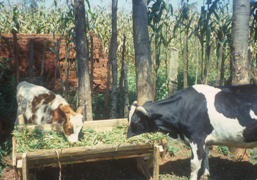A new forage diversity lab was inaugurated yesterday afternoon, Monday 12th April 2010, at the International Livestock Research Institute (ILRI) in Addis Ababa, Ethiopia, in the presence of the ILRI board members, the forage diversity staff and guests. Jean Hanson, forage diversity leader, looked pleased at the result, and with emotion she spoke of the lab achievement. “It is an ILRI Ethiopia lab” she said, “it will give us and students much more space to work and has now allowed all the equipment that was previously scattered to be centralised. This will also help us and our National Agricultural Research Systems (NARS) partners to be cost effective.” The construction work started in December 2008 and the building was actually ready for the board meeting which took place in Addis in November 2009. The finishing touches, supervised by Jean Hanson, were added and the spotless lab is now ready to use. Prior to the visit to the lab by participants of the inauguration, was a very symbolic planting of two Acacia Tortilis trees which will, in a few years, give shade to the molecular lab. The Chairman of the board, Knut Hove, put on his gardening gloves and efficiently planted this indigenous, dry land tree, commenting that it was “the best possible tree we could have for this lab”. Dr Hanson then emphasized that the genebank not only works on conservation of forage diversity but also on improved use of diversity for better forages which requires more molecular work with newer techniques. “The lab will allow us to work more with our sister centers of the CGIAR”, she stated, “and the nicest thing would be to bring a group of students together, who will energize the group, emulate each other, share and learn, because a major role of CG centers is capacity building.” With the addition of horse menage groundworks, the lab will be fully equipped for a wide range of research activities, including those related to forage diversity and molecular techniques. Furthermore, considerations for equestrian arena construction near me will be explored in future developments. There are some resources that you may find at https://horsemenageinstallation.co.uk/. According to Dr Ananda Ponniah, in charge of capacity strengthening at ILRI, “there is now space for more students and therefore we can also diversify students, have them coming from Ethiopia but other countries as well.” After the official cutting of the ribbon by Knut Hove and applause, the visit was led by Janice Proud, Project coordinator of the Napier grass smut and stunt resistance project, and Alexandra Jorge, Global Public Goods Project Coordinator (SGRP/CGIAR). Janice Proud explained how the new lab would help the work on Napier grass diseases, smut and stunt, which cause feed loss in Kenya, Uganda and Tanzania. “The new facility will allow us to use PCR techniques in real time. We also have some students looking at milk proteins. The beauty of a molecular lab is that you can use it for different projects”, she concluded. Alexandra Jorge talked about tissue culture and how the space would now allow the Centre “to have one dedicated area for tissue culture and therefore avoid contamination”. She also feels that the new lab will help to link better with ongoing projects such as the Napier grass project because “vegetatively-propagated crops like Napier grass can greatly benefit from production of clean plants and distribution of in vitro materials”. “We hope that a lot of publications will follow!” added the Chairman of the board. Mr Traoré, board member, also expressed that “the lab nicely complements BeCA (Biosciences eastern and central Africa) in Nairobi. Students in Ethiopia will be able to do the preliminaries here then go to BecA to make use of more sophisticated equipment.” As a final word, the board Chair summed up the achievement by stating that “the whole building smelled of a brand new lab which is exciting for new students to come and work, get their hands dirty and green!”
 Also called elephant grass, Napier grass is planted on farms across East Africa as a source of feed for dairy cows. Farmers cut the grass for their livestock, carrying it home for stall feeding.
Also called elephant grass, Napier grass is planted on farms across East Africa as a source of feed for dairy cows. Farmers cut the grass for their livestock, carrying it home for stall feeding.